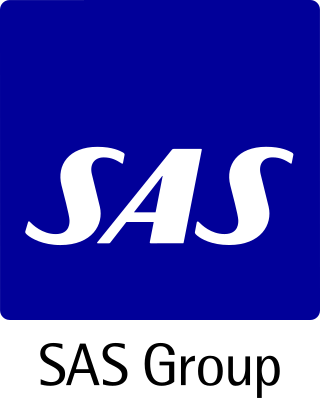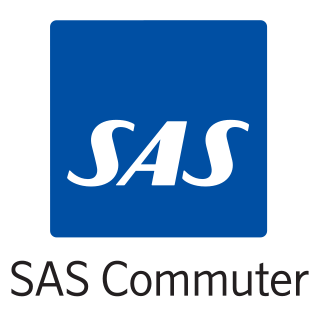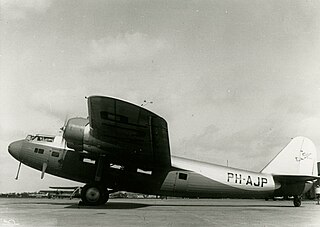The Societé anonyme belge d'Exploitation de la Navigation aérienne, better known by the acronym Sabena or SABENA, was the national airline of Belgium from 1923 to 2001, with its base at Brussels Airport. After its bankruptcy in 2001, SN Brussels Airlines was formed through a takeover of former subsidiary Delta Air Transport and took over part of Sabena's assets in February 2002. SN Brussels Airlines merged with Virgin Express in 2007 to form Brussels Airlines. The airline's corporate headquarters were located in the Sabena House on the grounds of Brussels Airport in Zaventem.

Stockholm Arlanda Airport is an international airport located in the Sigtuna Municipality of Sweden, near the town of Märsta, 37 kilometres (23 mi) north of Stockholm and nearly 40 kilometres (25 mi) south-east of Uppsala. The airport is located within Stockholm County and the province of Uppland. It is the largest airport in Sweden and the third-largest airport in the Nordic countries. The airport is the major gateway to international air travel for large parts of Sweden. Arlanda Airport was used by nearly 27 million passengers in 2017, with 21.2 million international passengers and 5.5 million domestic. The facility covers an expanse of about 2,500 hectares (9.7 sq mi) of airport property.

Stockholm/Bromma Airport is a Swedish domestic and minor international airport in Stockholm. The operator calls the airport Bromma Stockholm Airport. It is located 4 NM west-northwest of downtown Stockholm and is the closest to the city compared to the other commercial passenger airports in the area around Stockholm. Stockholm/Bromma is Sweden's third-busiest airport by passenger traffic and take-offs and landings as of 2015.

Linjeflyg was a Swedish domestic airline, formed in 1957 as a domestic subsidiary by Scandinavian Airlines System and Airtaco as well as by newspaper publishers Dagens Nyheter AB and Stockholms-Tidningen AB.

Aerolíneas Nicaragüenses S.A., operating as Aeronica, was an airline based in Nicaragua. Headquartered in the capital Managua, it operated scheduled passenger flights within Central America, as well as to Mexico City and the United States from its hub at the city's Augusto C. Sandino International Airport.

SAS AB, trading as SAS Group, is an airline holding company headquartered in the SAS Frösundavik Office Building in Solna Municipality, Sweden. It is the owner of the airlines Scandinavian Airlines and SAS Connect. SAS once owned 19.9% of the now defunct Spanish airline Spanair as well as shares in Estonian Air and Skyways Express. SAS Group is partially owned by the governments of Sweden and Denmark with a 14.82% and 14.24% holding, respectively. The remaining 70.92% is held by private shareholders, of which Foundation Asset Management owns 6.50%. The company is listed on the Oslo Stock Exchange, the Stockholm Stock Exchange, and the Copenhagen Stock Exchange.

Malmö Airport, until 2007 known as Sturup Airport is Sweden's fourth busiest airport, handling 1,975,479 passengers in 2019. The airport is located in Svedala Municipality, approximately 28 kilometres (17 mi) east of Malmö and 26 kilometres (16 mi) south-east of Lund.

The Saab 90 Scandia was a civil passenger aeroplane, manufactured by Svenska Aeroplan Aktiebolaget (SAAB), in Linköping, Sweden. In 1944, as it was becoming clear that hostilities in Europe would soon be at an end, SAAB realised that the company had to diversify from purely military endeavours if it were to survive. The board therefore decided to put into action a plan to manufacture a twin-engined, short- to medium-haul passenger aircraft, as a successor for the Douglas DC-3.

SAS Commuter, also branded as Scandinavian Commuter, was a regional airline which operated in Denmark, Norway and Sweden. A sister company of Scandinavian Airlines (SAS), it operated various regional services on behalf of the Scandinavian flag carrier. The airline was headquartered at Copenhagen Airport, which also served as its main base. It later also operated bases at Tromsø Airport; Stockholm Arlanda Airport; Trondheim Airport, Værnes and Bergen Airport, Flesland.
Svensk Interkontinental Lufttrafik AB, SILA, trading internationally as Swedish Intercontinental Airlines, was an airline formed in 1943 by banker Marcus Wallenberg Jr. An early president of the airline was Per Norlin. In August 1946 with Danish Air Lines and Norwegian Air Lines it became a part of a three-airline consortium that would eventually merge on 30 June 1948 with a pooled capitalization of $25 million as Scandinavian Airlines. The airline operated Douglas DC-4 and Boeing B-17 Flying Fortress aircraft.
Det Norske Luftfartselskap A/S or DNL, trading internationally as Norwegian Air Lines, was an airline and flag carrier of Norway. Founded in 1927, it operated domestic and international routes from 1935 to 1941 and from 1946 to 1951. It became one of the three founders of Scandinavian Airlines System (SAS) and became one of its three holding companies from 1951, with a 28% stake and listed on the Oslo Stock Exchange. DNL was renamed SAS Norge ASA in 1996 and was merged in 2001 to create the SAS Group.

The Fokker F.XXII was a 1930s Dutch four-engined 22-passenger airliner designed and built by Fokker.
Det Danske Luftfartselskab A/S or DDL, trading in English as Danish Air Lines, was Denmark's national airline from 1918 until it merged to create Scandinavian Airlines System (SAS) in 1951. DDL was established on 29 October 1918, but started its first scheduled route on 7 August 1920.

Swedair AB was a Swedish regional airline that existed from 1935 to 1994. It was founded as Svensk Flygtjänst AB by Tor Eliasson, who was CEO until his death in 1971. The companies last manageing director was Lars svanstrom

Braathens South American & Far East Airtransport A/S or Braathens SAFE was founded by ship-owner Ludvig G. Braathen in 1946. It started as a charter airline based at Oslo Airport, Fornebu in Norway, flying to destinations in the Far East and in South America. At first the airline used Douglas DC-4s, and later also Douglas DC-3s. In 1948, the airline moved to Oslo Airport, Fornebu and started regular scheduled flights to the Far East. In 1952, the airline started cooperation with the Icelandic airline Loftleidir, where until 1960 the two airlines in cooperation flew flights to Reykjavík. Domestic services started in 1951, using de Havilland Herons on a route from Oslo to Stavanger via Tønsberg. Braathens SAFE also established at Stavanger Airport, Sola. A second route was started two years later to Trondheim. The Heron routes also stopped in Farsund, Kristiansand, Notodden to Stavanger and Hamar, Røros to Trondheim.

The history of Scandinavian Airlines System (SAS) from 1933 to 1951 covers the first attempts at transatlantic travel, the establishment of a consortium and finally the establishment of the consolidated SAS. Aerotransport, the national airline of Sweden, and Det Norske Luftfartselskap (DNL), the national airline of Norway, both started planning transatlantic routes in the mid-1930s. By 1939, negotiations were started with Det Danske Luftfartselskab (DDL) of Denmark, and by 1940 services were to begin. Because of the German occupation of Denmark and Norway, the plans collapsed. In Sweden, Svensk Interkontinental Lufttrafik (SILA) was founded to start private transatlantic flights, which commenced in 1945. Negotiations were started again, and in 1946 the consortium Overseas Scandinavian Airlines System (OSAS) was established to start routes to New York and South America.
Skyline was a Swedish charter airline which operated from 1971 to 1978. It had a fleet of Vickers Viscount aircraft, operating between one and three at any given time and a total of five aircraft. Based in Malmö, it initially flew out of Malmö Bulltofta Airport. The airport closed in 1972 and Skyline moved to Malmö Sturup Airport.

Per Adolf Norlin was a Swedish businessman. He was CEO of Swedish Intercontinental Airlines (SILA), Scandinavian Airlines (SAS) and AB Aerotransport (ABA).













